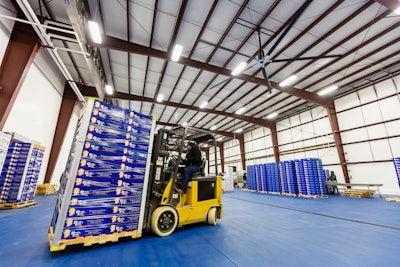
When evaluating the need for industrial high-volume, low-speed (HVLS) fans, every food manufacturing facility application has its unique challenges.
Some structures require constant cooling for product protection, and others in cold climates require increased air circulation for even heat distribution. Some interior spaces stay dry year-round, and others have floors that notoriously sweat because of high humidity or become wet from outdoor elements getting inside.
And, while even just one HVLS fan can provide powerful air movement using low amounts of energy, the majority of facilities looking at HVLS fans intend to install multiple fans. These facilities can realize the biggest benefits by networking their HVLS fans with a sophisticated multi-fan control system and integrating that system into their building automation system (BAS).
As you can see, there’s more to such fans than many people realize. In the end, achieving your desired outcomes ensures that you’ll gain the maximum benefit out of your HVLS fans investment.
5 important fan planning factors
First, let’s address overall fan planning. When done correctly, it will not only ensure a successful outcome, but also zero headaches later on. Regardless of a fan project’s size and scope, here are five important planning factors you need to address from the start:
1. Establish goals early to ensure the right results later. Determine what you realistically expect to achieve. Ask yourself what critical goals you need to meet once fans are installed and operating. You never want to find out after the fact that your fans are not providing the results you had anticipated.
2. Don’t slip up on wet floors, summer comfort or product protection. Three important HVLS industrial fan benefits include improving workplace safety by drying out wet floors, keeping employees cool during hot weather and protecting valuable perishables. The key is to place HVLS industrial fans in the locations where they are going to provide the maximum amount of benefit.
3. More questions are always better than not enough questions. The best way to measure the progress of your HVLS industrial fan planning process is to evaluate how genuinely interested a fan provider is about a specific application. Are they just quickly assessing your needs to come up with a specific quantity of fans for you to purchase? Or, are they taking the time to clearly understand your goals, and then making a substantive and sound recommendation based on a thorough analysis of your environment?
4. Typical industrial spacing is not always so “typical.” Fact is, every facility has very different needs. Whether a facility needs to replace improperly spaced fans from another provider or needs to embark on a new industrial HVLS fans project, a provider with an engineering perspective about proper fan spacing will be a huge benefit in the long run.
5. Juggling multiple facility issues to achieve multiple solutions. While every facility has unique airflow challenges, structures of all shapes and sizes often face a variety of simultaneous air movement issues that require different solutions. One area of a facility might have stagnant air while another area has ongoing problems with wet floors. On top of that, you might have an area that your HVAC is trying to keep cool during the hottest months of the year, but it’s not keeping up. The best way to handle these types of challenges is to address them independently.
Adding HVLS fans to a facility by first following these planning factors will undoubtedly provide huge benefits. Now let’s address how networking fans with a sophisticated multi-fan control system and integrating controls with a BAS will help realize centralized control, time savings for facility managers, maximum performance and energy savings and the ability to quickly handle operational issues.
Centralized control from a single touchscreen
A robust fan control system provides facility operators the ability to control a building of fans from a single location within the building. The fans are daisy-chained through wire conductor cables with the last fan connected to the computer controls.
The fans can be set up in groups (or zones), so that authorized operators can control individual fans, a zone of fans or even the entire facility at one time from the touchscreen. Facility managers can then monitor the fans from a central location and make real-time adjustments.
Integrating the fan control system with the BAS provides the most centralized experience for users. Although all the top HVLS fan manufacturers have the ability to integrate controls into the BAS, the method that each manufacturer uses can be different. According to the Consulting-Specifying Engineer 2019 HVAC and Building Automation Systems Study, four out of 10 engineers reported that one of their top challenges when designing a BAS is interoperability and complementing system controls.
Engineers and facility managers considering HVLS fans need to factor in the capabilities of the control system software and its ability to integrate into a BAS. Some control systems only allow managers to monitor information about the fans within the BAS, but they still have to go to the control system itself to make adjustments.
The most sophisticated control systems, however, provide flexibility to integrate into the BAS in multiple ways, including the ability to allow the fan control system to act as either master or slave. Building planners can then spec HVLS fans into their system with confidence, knowing that as systems change and grow in sophistication, their fan control system can keep pace and adapt to changes in requirements.
Time savings for more pressing matters
A robust control system allows facility operators to save time for more pressing matters by being able to monitor all of the fans from one central location rather than inefficiently managing separate pieces of equipment individually.
The most comprehensive systems also include “set it and forget it” features. These allow operators to set fans so that they turn on automatically, adjust for speed, and then turn off at set times or temperatures.
And, as automation and Internet of Things (IoT) components of building management solutions gain sophistication, so too should HVLS fan controls. The best controls are already developing the capability to integrate into automation solutions, allowing for remote web-based monitoring and control of fans, real-time performance metrics and companion mobile apps for constant insight into the operation of fans in a facility.
Maximizing your fans’ performance
Standing under an HVLS fan, you can definitely feel the air getting more comfortable, but how do you know the fan’s performing at its peak potential? How can you prove that your fan’s providing you the maximum return on investment? Not without ways to measure the changes in temperature, energy used by the fans, energy saved by not using your HVAC as much, and other key metrics.
While considering the right HVLS fan controls for your facility, look for systems that record these key metrics. The most sophisticated software tracks and archives all the information coming in from each fan. That data, in return, can be collected and analyzed, and operational adjustments can be made. The right control system integrated with your BAS will allow you to pull fan performance data together with data from your HVAC, lighting and other systems.
Tools for identifying operational issues
Even the best equipment isn’t perfect 100% of the time, and breakdowns can be felt in both wasted employee time and in the facility’s performance and bottom line. The ability to handle issues with any equipment quickly and easily as they come up is crucial to maintaining maximum efficiency. A quality control system includes tools for identifying operational issues.
The most robust of these systems includes the ability to troubleshoot issues remotely, right from your central interface, and even allow you to send a work order straight from the system. The local service provider can receive the diagnosed problem and arrive with the correct part, so the maintenance trip is as efficient as possible.
Wrong choices can cost money
It doesn’t pay to run the risk of making an unsound decision—or worse yet—a series of potentially expensive mistakes about industrial HVLS fan investment. Making the wrong choice could end up costing your company or business thousands of dollars to correct if your fans don’t end up providing the results expected throughout a facility.















